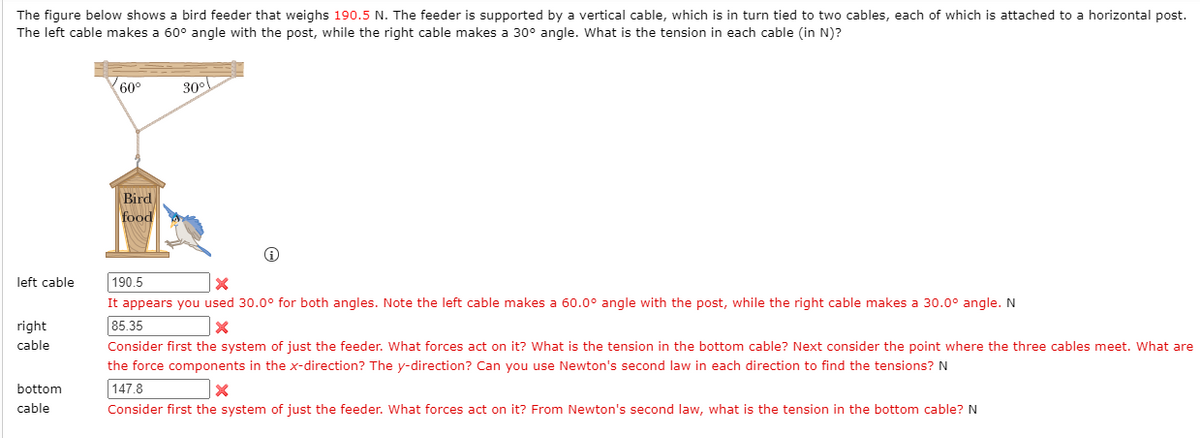The figure below shows a bird feeder that weighs 190.5 N. The feeder is supported by a vertical cable, which is in turn tied to two cables, each of which is attached to a horizontal post. The left cable makes a 60° angle with the post, while the right cable makes a 30° angle. What is the tension in each cable (in N)? 60° 30° Bird food 190.5 It appears you used 30.0° for both angles. Note the left cable makes a 60.0° angle with the post, while the right cable makes a 30.0° angle. N 85.35 left cable right cable Consider first the system of just the feeder. What forces act on it? What is the tension in the bottom cable? Next consider the point where the three cables meet. What are the force components in the x-direction? The y-direction? Can you use Newton's second law in each direction to find the tensions?N 147.8 Consider first the system of just the feeder. What forces act on it? From Newton's second law, what is the tension in the bottom cable? N bottom cable
The figure below shows a bird feeder that weighs 190.5 N. The feeder is supported by a vertical cable, which is in turn tied to two cables, each of which is attached to a horizontal post. The left cable makes a 60° angle with the post, while the right cable makes a 30° angle. What is the tension in each cable (in N)? 60° 30° Bird food 190.5 It appears you used 30.0° for both angles. Note the left cable makes a 60.0° angle with the post, while the right cable makes a 30.0° angle. N 85.35 left cable right cable Consider first the system of just the feeder. What forces act on it? What is the tension in the bottom cable? Next consider the point where the three cables meet. What are the force components in the x-direction? The y-direction? Can you use Newton's second law in each direction to find the tensions?N 147.8 Consider first the system of just the feeder. What forces act on it? From Newton's second law, what is the tension in the bottom cable? N bottom cable
College Physics
1st Edition
ISBN:9781938168000
Author:Paul Peter Urone, Roger Hinrichs
Publisher:Paul Peter Urone, Roger Hinrichs
Chapter9: Statics And Torque
Section: Chapter Questions
Problem 3PE: Two children push on opposite sides of a door during play. Both push horizontally and perpendicular...
Related questions
Question

Transcribed Image Text:The figure below shows a bird feeder that weighs 190.5 N. The feeder is supported by a vertical cable, which is in turn tied to two cables, each of which is attached to a horizontal post.
The left cable makes a 60° angle with the post, while the right cable makes a 30° angle. What is the tension in each cable (in N)?
60°
30°
Bird
food
190.5
It appears you used 30.0° for both angles. Note the left cable makes a 60.0° angle with the post, while the right cable makes a 30.0° angle. N
left cable
85.35
right
cable
Consider first the system of just the feeder. What forces act on it? What is the tension in the bottom cable? Next consider the point where the three cables meet. What are
the force components in the x-direction? The y-direction? Can you use Newton's second law in each direction to find the tensions? N
147.8
Consider first the system of just the feeder. What forces act on it? From Newton's second law, what is the tension in the bottom cable?N
bottom
cable
Expert Solution
This question has been solved!
Explore an expertly crafted, step-by-step solution for a thorough understanding of key concepts.
This is a popular solution!
Trending now
This is a popular solution!
Step by step
Solved in 3 steps with 3 images

Recommended textbooks for you

College Physics
Physics
ISBN:
9781938168000
Author:
Paul Peter Urone, Roger Hinrichs
Publisher:
OpenStax College

College Physics
Physics
ISBN:
9781305952300
Author:
Raymond A. Serway, Chris Vuille
Publisher:
Cengage Learning

Glencoe Physics: Principles and Problems, Student…
Physics
ISBN:
9780078807213
Author:
Paul W. Zitzewitz
Publisher:
Glencoe/McGraw-Hill

College Physics
Physics
ISBN:
9781938168000
Author:
Paul Peter Urone, Roger Hinrichs
Publisher:
OpenStax College

College Physics
Physics
ISBN:
9781305952300
Author:
Raymond A. Serway, Chris Vuille
Publisher:
Cengage Learning

Glencoe Physics: Principles and Problems, Student…
Physics
ISBN:
9780078807213
Author:
Paul W. Zitzewitz
Publisher:
Glencoe/McGraw-Hill

College Physics
Physics
ISBN:
9781285737027
Author:
Raymond A. Serway, Chris Vuille
Publisher:
Cengage Learning

Physics for Scientists and Engineers, Technology …
Physics
ISBN:
9781305116399
Author:
Raymond A. Serway, John W. Jewett
Publisher:
Cengage Learning